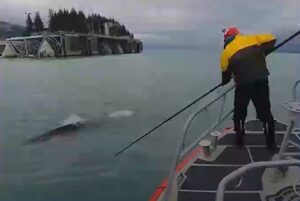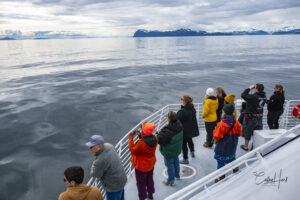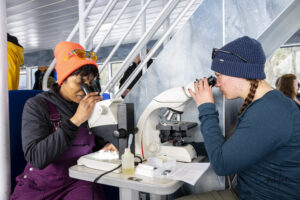
Each year in early December, the Council hosts our annual Science Night. We invite experts to share about their scientific work and programs that are relevant to the Exxon Valdez oil spill region.
In 2024, the Council partnered with several local organizations to host community watch parties for the first time. We are grateful to our host partners: the Prince William Sound Science Center in Cordova, Kenai Peninsula College in Homer, and Prince William Sound College in Valdez. Each organization invited community members to gather in their facilities to watch the broadcast from Anchorage.
Science Night 2024: Staying alert and proactive in the Exxon Valdez oil spill region
This event highlighted four programs.
- John Moran, a Research Fisheries Biologist from the Alaska Fisheries Science Center shared about how he and his team of trained responders freed an entangled humpback whale in Valdez in 2024.
- Kristina Arsenault, a Marine Transportation System Specialist (Cyber) from the U.S. Coast Guard’s Marine Safety Unit in Valdez spoke on marine cybersecurity.
- Andy Schroeder and Scott Farling, Co-Founders of Ocean Plastics Recovery Project, shared about their marine debris cleanup and recycling efforts focused on the Southcentral Alaska coast.
- Finally, Barbara Callahan, Senior Director of Response and Preparedness Services at the International Bird Rescue presented about innovations in oiled wildlife response since the Exxon Valdez spill.
Dr. Sarah Allan, chair of the Council’s Scientific Advisory Committee, attended the watch party in Homer. She had attended broadcasts in previous years as an individual attendee, and shared that it was “more engaging to watch with a group and we had some good side conversations about the presentations.”
Watch Science Night 2024 online
All four presentations are available to view on the Council’s website: Science Night 2024
Join us for Science Night 2025
For Science Night 2025, we hope to build on these successful watch parties by enhancing the opportunities for communities to gather and experience the event together based on feedback we received. We also hope to expand to other communities within the Council’s region. If you have interest in hosting a watch party for your community, please contact me at maia.draper-reich@pwsrcac.org.
 On May 1, Council volunteers and staff joined local high school and college students, educators, and other partners on a cruise to Bligh Reef, where the Exxon Valdez oil tanker ran aground in 1989.
On May 1, Council volunteers and staff joined local high school and college students, educators, and other partners on a cruise to Bligh Reef, where the Exxon Valdez oil tanker ran aground in 1989. Participants also had the opportunity to engage in an activity titled “Voices from the Spill,” which involved reading personal stories of the Exxon Valdez oil spill and its aftermath, and then respond through creative writing or art.
Participants also had the opportunity to engage in an activity titled “Voices from the Spill,” which involved reading personal stories of the Exxon Valdez oil spill and its aftermath, and then respond through creative writing or art.